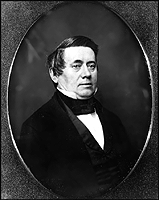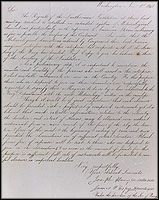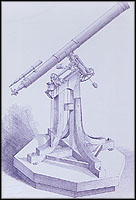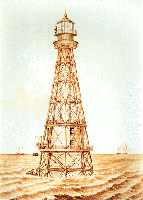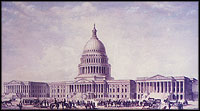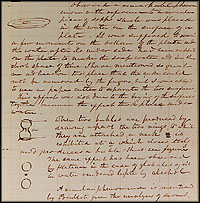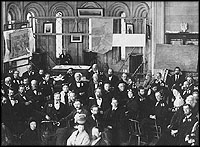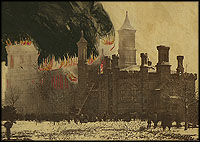Joseph Henry's Smithsonian YearsBy Frank Rives MillikanHistorian, Joseph Henry Papers Project No one person influenced the development of the Smithsonian Institution more than its first Secretary (director), physicist and educator Joseph Henry. This exhibit provides a brief introduction to Henry and his years at the institution. Joseph Henry, First Secretary
Supporting Research
Henry considered Smithsonian Contributions to Knowledge to be the most significant element of his program for the new institution. This scholarly publication, begun in 1848 and usually published annually, disseminated original research in a wide variety of fields, including archaeology, astronomy, chemistry, and natural history. As Henry realized, papers in natural history often required expensive illustrations, and without support from an institution such as the Smithsonian "many valuable articles [would] never see the light" (Henry to Samuel Foster Haven, October 19, 1847). The lithograph shown here is from William Henry Harvey, "Nereis Boreali-Americana, or Contributions to a History of Marine Algae of North America," Smithsonian Contributions to Knowledge, vol. 5 (Washington, 1853). Tracking the Weather
Henry hoped that by coordinating widespread meteorological observations, the Smithsonian could contribute to "solving the problem of American storms" ("Programme of Organization of the Smithsonian Institution," 1847). By the end of 1849, he had established a network of some 150 volunteer observers, who regularly reported data on temperature, rainfall, barometric pressure, and the like. The meteorological project was the institution's first major scientific undertaking and was a precursor of today's National Weather Service. See "Joseph Henry: Father of the Weather Service." Seeding Science
Henry often used the Smithsonian's private funds to fill gaps in federal support of science. For instance, when the U.S. Naval Astronomical Expedition to Chile lacked critical equipment, Henry purchased meteorological instruments for the expedition and obtained this equatorial telescope. Congress eventually appropriated funds for the telescope. The photograph shown here is taken from James Melville Gilliss, The U.S. Naval Astronomical Expedition to the Southern Hemisphere, during the Years 1849-'50-'51-'52, vol. 3 (Washington, 1856). Light-House Board
As head of the Smithsonian, Henry found little time for his own research. He did continue to conduct some experiments and, more importantly, to advise the government as well as private individuals on scientific matters. Henry served, for example, on the U.S. Light-House Board from its inception in 1852 to his death in 1878. During these years he was chairman of the committee on experiments; from 1873 to 1878 he was also chairman of the board. Henry is generally credited with professionalizing the board while introducing numerous innovations through experiments he conducted or initiated on methods of illumination and on the acoustics of fog signals. U.S. Capitol Building
Congressmen consulted Henry about various aspects of the U.S. Capitol throughout his tenure as Secretary. In 1850 he drafted a congressional report for Jefferson Davis on the extension of the Capitol, and he subsequently conducted experiments related to the building's marble, heating and ventilating, and acoustics. Some of his suggestions were incorporated in Thomas U. Walter's renovations and extension of the Capitol in the 1850s and 1860s. Testing Marble
Henry examined a variety of materials to study the effects of molecular forces. He recorded experiments on soap bubbles in his laboratory notebook, shown here. He later presented the results to the American Association for the Advancement of Science in an 1851 paper titled "On Cohesion." Alert to the practical applications of basic research, Henry devised methods for testing the cohesive force of particles in the marble being considered for use in the U.S. Capitol extension. National Academy of Sciences
Henry, seated behind desk, presided at this 1871 meeting of the National Academy of Sciences in the west wing of the Smithsonian Building. As president of the academy from 1868 until his death ten years later, he struggled to make it an adviser to government and a champion of basic research. He spearheaded efforts to define the relationship between the federal government and the American scientific community. Henry and Bell
Henry demonstrated this telephone transmitter made by Philipp Reis to twenty-seven-year-old Alexander Graham Bell in 1875. On that occasion, Bell showed his own sound-transmitting device to Henry, who encouraged him to pursue the invention of the telephone. "Such a chimerical idea as telegraphing vocal sounds would indeed to most minds seem scarcely feasible," Bell wrote his parents after his visit with Henry. But Henry convinced him that it was feasible. See "Joseph Henry and the Telephone." Documenting Henry's Smithsonian
Most of the Smithsonian's early records were destroyed in 1865, when a fire damaged a portion of the Smithsonian Building. The Smithsonian annual report for 1865 put the loss at 85,000 pages of letters. In searching about 300 repositories around the world for correspondence to and from Henry, the Joseph Henry Papers Project (part of the Institutional History Division of the Smithsonian Institution Archives) has located original drafts of some of these letters as well as some of the correspondence sent out during this period under Henry's name. These documents help flesh out the story of how Henry shaped the Smithsonian and, more broadly, how he used his position as Secretary of the Smithsonian Institution from 1846 to 1878 to advance the cause of science in America. For more on Joseph Henry, see the web site of the
Joseph Henry Papers Project. See also Marc Rothenberg et al., editors,
The Papers of Joseph Henry, beginning with volume 7, for coverage of
Henry's years at the Smithsonian.
|
